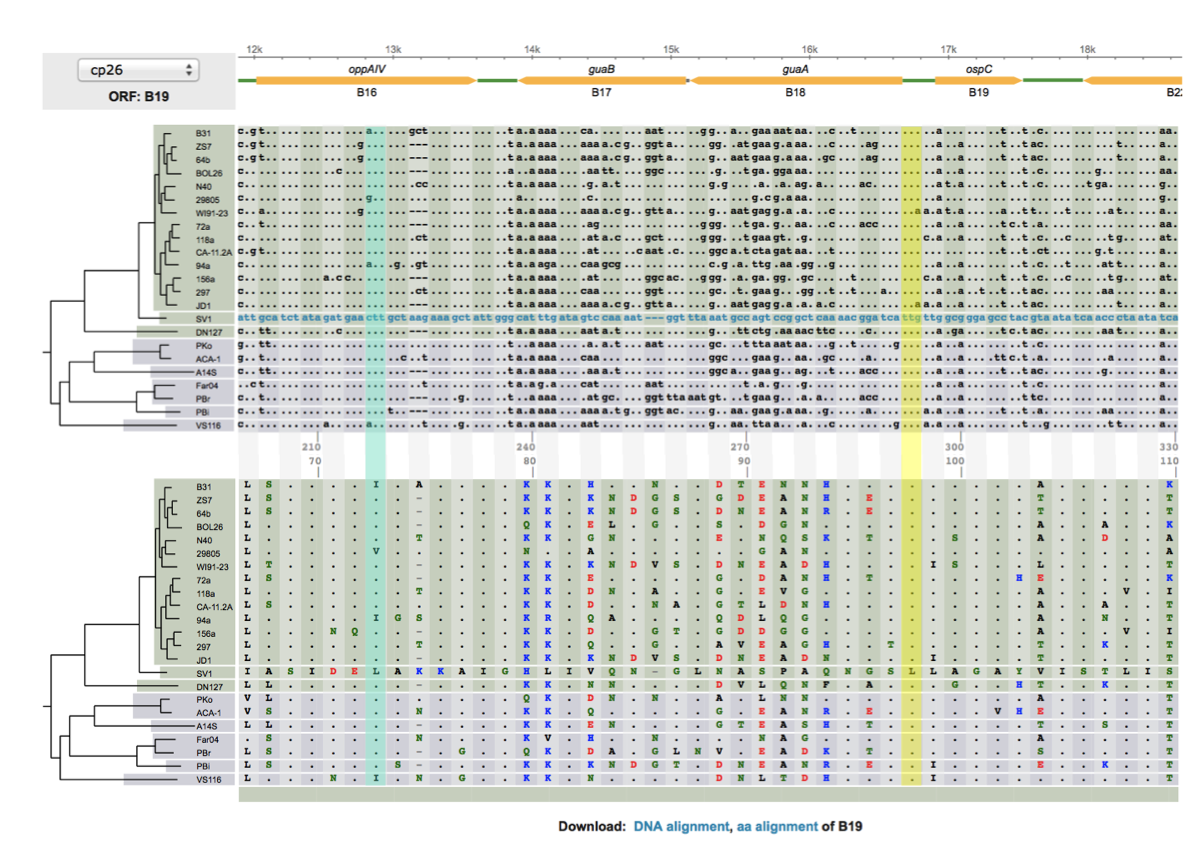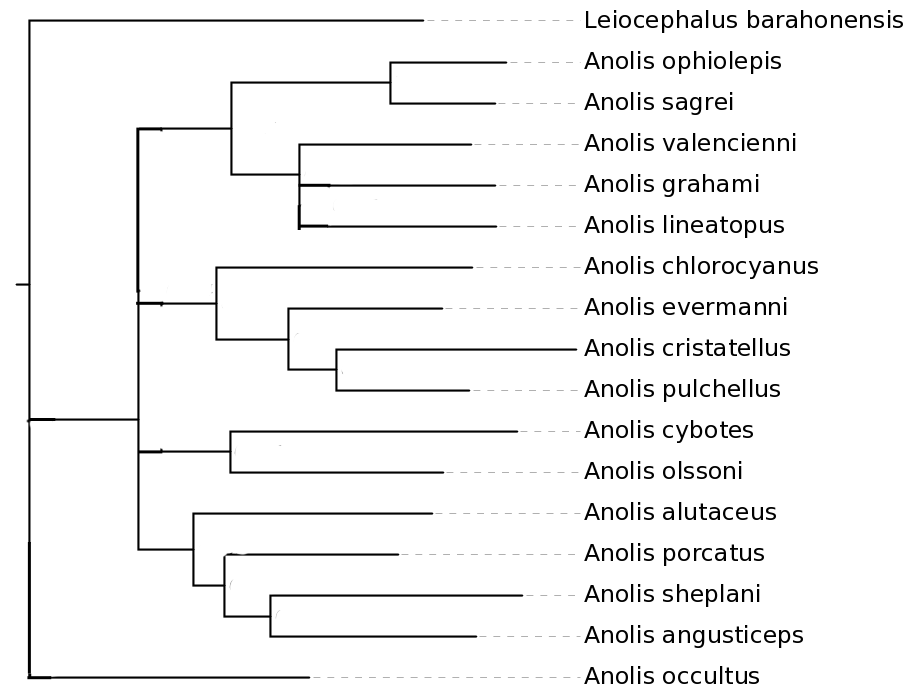Biol375 2014: Difference between revisions
imported>Weigang |
imported>Weigang |
||
| Line 148: | Line 148: | ||
# Assuming that the total number of synonymous sites S=174 and the total number of nonsynonymous sites N=690, calculate <i>d<sub>s</sub> and d<sub>n</sub></i> (with Jukes-Cantor correction) | # Assuming that the total number of synonymous sites S=174 and the total number of nonsynonymous sites N=690, calculate <i>d<sub>s</sub> and d<sub>n</sub></i> (with Jukes-Cantor correction) | ||
|} | |} | ||
* 11/13 (TH). Tree-testing (Chapter 6). Lecture slides: [[File:Part-3-tree-construction-small.pdf|thumbnail]] | * 11/13 (TH). Tree-testing & Review (Chapter 6). Lecture slides: [[File:Part-3-tree-construction-small.pdf|thumbnail]] | ||
* 11/17 (M). '''Midterm Exam 3''' | * 11/17 (M). '''Midterm Exam 3''' | ||
Revision as of 23:42, 12 November 2014
Course Description
Molecular evolution is the study of the change of DNA and protein sequences through time. Theories and techniques of molecular evolution are widely used in species classification, biodiversity studies, comparative genomics, and molecular epidemiology. Contents of the course include:
- Population genetics, which is a framework of understanding mechanisms of sequence evolution through mutation, recombination, gene duplication, genetic drift, and natural selection.
- Molecular systematics, which introduces statistical models of sequence evolution and methods of reconstructing species phylogeny.
- Bioinformatics, which provides hands-on training on data acquisition and the use of software tools for phylogenetic analyses.
This 3-credit course is designed for upper-level biology-major undergraduates. Hunter pre-requisites are BIOL203, and MATH150 or STAT113.
Textbooks
- (Required) Roderic M. Page and Edward C. Holmes,1998, Molecular Evolution: A phylogenetic Approach, Blackwell Science Ltd.
- (Recommended) Baum & Smith, 2013. Tree Thinking: an Introduction to Phylogenetic Biology, Roberts & Company Publishers, Inc.
Learning Goals
- Understand mechanisms of DNA sequence evolution
- Be able to describe evolutionary relationships using phylogenetic trees
- Understand the computational algorithms for building phylogenetic trees
- Be able to use web-based as well as stand-alone software to infer phylogenetic trees
Links for phylogenetic tools
Exams & Grading
- Assignments. All assignments should be handed in as hard copies only. Email submission will not be accepted. Late submissions will receive 10% deduction (of the total grade) per day.
- Three Mid-term Exams (30 pts each)
- Comprehensive Final Exam (50 pts)
Bonus for active participation in classroom discussions
Academic Honesty
While students may work in groups and help each other for assignments, duplicated answers in assignments will be flagged and investigated as possible acts of academic dishonesty. To avoid being investigated as such, do NOT copy anyone else's work, or let others copy your work. At the least, rephrase using your own words. Note that the same rule applies regarding the use of textbook and online resources: copied sentences are not acceptable and will be considered plagiarism.
Hunter College regards acts of academic dishonesty (e.g., plagiarism, cheating on examinations, obtaining unfair advantage, and falsification of records and official documents) as serious offenses against the values of intellectual honesty. The College is committed to enforcing the CUNY Policy on Academic Integrity and will pursue cases of academic dishonesty according to the Hunter College Academic Integrity Procedures.
Course Schedule
Part 1. Tree Thinking
- 8/28 (TH). Overview & Introduction. Lecture slides:
| Assignment 1 (10 pts; Due: 9/4, Thursday) |
|---|
- 9/1 (M). Labor Day. No class
- 9/4 (TH). 1.1. Introduction (Continued). In-class exercise 1.
| Assignment 2 (5 pts; Due: 9/8, Monday) |
|---|
Watch Origin of Species: Lizards in an Evolutionary Tree. Provide short answer (1-3 sentences) to each of the following three questions.
|
- 9/8 (M). 2.1. Intro to trees
- 9/11 (TH). 2.2 & 2.3. Tree Distance. In-class exercise 2.
| Assignment 3 (5 pts; Due: 9/15, Monday) |
|---|
| Computer exercise. Obtain an account on EvolView. Once logged in, under the "Basic" tab, click the first icon & copy and paste the following NEWICK string: "(monkey:0.09672,((tarsier:0.18996,lemur:0.14790)0.999:0.09005,(macaque:0.18524,(gibbon:0.10388,(orang-utan:0.09481,(human:0.03391,(gorilla:0.06135,chimpanzee:0.05141):0.01580)0.316:0.05381)1.000:0.03019)0.978:0.05616)0.997:0.05042)0.965:0.09672);". Name your project as "Assignment 3" and the tree as "primate". Render the tree in all five available formats. Using the "Export" tab to download all tree graphs (in "jpeg" or "png" format). Copy and Paste your tree graphs into a single page of Microsoft Word or PowerPoint. Turn in a printed hard copy. |
- 9/15 (M). 2.4 & 2.5. Species Tree & Lineage Sorting
- 9/18 (TH). 2.5. Consensus Tree & Review. Chapter 2 Slides:File:Part-1-tree-thinking.pdf. In-class Exercise 3:
- 9/22 (M). Midterm Exam I
Part 2. Trait Evolution
- 9/25 (TH). Holiday Recess. No Class
- 9/29 (M). Traits & trait matrix
| Assignment #4 (5 pts; Due 10/6) |
|---|
| Based on the lizard card, construct a character-state matrix for all lizard species. For each species, list its character state for each of the following two characters (as columns): (1) Geographic origin, and (2) Habitat. Re-watch the video may help this assignment. Hint: use Excel & hand in a printout of your Excel sheet. |
- 10/2 (TH). Homoplasy & consistency
- 10/6 (M). Parsimony reconstruction (Chapter 5). In-Class Exercise 4:
| Assignment #5 (5 pts; Due 10/9) |
|---|
Use EvolView to display the following tree of Caribbean lizards: "((Anolis_chlorocyanus:0.15297,(Anolis_evermanni:0.09207,(Anolis_cristatellus:0.14363,Anolis_pulchellus:0.07962)0.931:0.02884)0.997:0.04280)0.897:0.02232,(Anolis_cybotes:0.17149,Anolis_olssoni:0.12747)0.974:0.03034,(((Anolis_ophiolepis:0.06969,Anolis_sagrei:0.06284)1.000:0.09480,(Anolis_valencienni:0.10249,(Anolis_grahami:0.10016,Anolis_lineatopus:0.10064)0.613:0.01700)0.999:0.04077)0.997:0.04169,((Leiocephalus_barahonensis:0.24783,Anolis_occultus:0.15489)0.978:0.05261,(Anolis_alutaceus:0.14271,(Anolis_porcatus:0.10377,(Anolis_sheplani:0.15083,Anolis_angusticeps:0.12285)0.943:0.02748)0.898:0.01870)0.989:0.03278)0.514:0.01385)0.404:0.01061);" Note:
|
- 10/9 (TH). Genome & gene structure (Chapter 3)
| Assignment #6 (10 pts; Due 10/16) |
|---|
|
- 10/13 (M). No Class
- 10/16 (TH). Genome and gene evolution. Lecture slides (with answer keys to assignments & in-class exercises):
- 10/20 (M). Review & Practices
- 10/23 (TH). Midterm Exam 2
Part 3. Tree Algorithms
- 10/27 (M). BLAST & Alignments (Chapter 5)
| Assignment #7 (5 pts; Due 11/3) |
|---|
Based on the NCBI Gene Page for cytochrome C (CYCS), answer the following questions:
|
- 10/30 (TH). Maximum parsimony (Chapter 6). In class exercise #6:
- 11/3 (M). Genetic distances (Chapter 6)
| Assignment #8 (5 pts; Due 11/10) |
|---|
An international team of scientists recently sequenced 99 genomes of ebola viruses. They reported their work in this recent publication.
|
- 11/6 (TH). Distance methods (Chapter 6).
- 11/10 (M). Likelihood methods (Chapter 6)
| Assignment #9 (5 pts; Due 11/13, Thursday) |
|---|
Compare these two Ebola VP30 sequences, one from the 2014 outbreak and the other from the 1994 outbreak.
|
- 11/13 (TH). Tree-testing & Review (Chapter 6). Lecture slides:
- 11/17 (M). Midterm Exam 3
Part 4. Population Genetics
- 11/20 (TH). Instructor traveling. No class
- 11/24 (M). TBD
- 12/1 (M). Instructor traveling. No class
- 12/4 (TH). TBD
- 12/8 (M). TBD
- 12/11 (TH). TBD
- 12/15 (M). Review
- 12/18 (TH) Comprehensive Final Exam (Regular class hours & Room)
- 12/31 (Wed). Grades Submitted to Registrar Offices (Hunter and Graduate Center)

